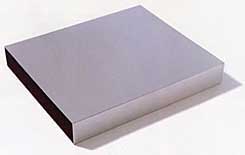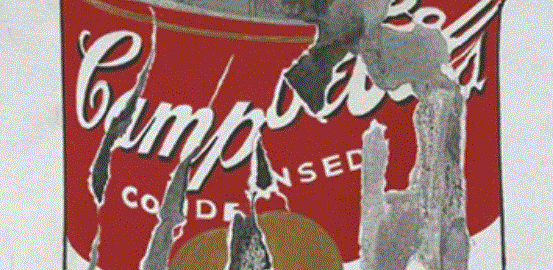Warhol’s $11.7 Million Dollar Soup Can
The May 9th feeding frenzy at Christie’s auction house in New York signifies a new level of absurdity for the art world. The New York Times dubbed it the evening when “Minimalism went mainstream.”
Walter Robinson, writing for artnet.com, politely referred to it as “irrational market exuberance,” and noted the otherworldly nature of it all, “A galvanized metal box, roughly two feet square and six inches deep, covered with a blue plastic lid — an untitled Donald Judd sculpture from 1985 — the work carried a presale estimate of $300,000-$400,000, and followed the sale of two dozen similar boxes for similarly high prices. $300,000 for a shallow metal box?”
Judd’s box eventually sold for $450,000. That evening’s auction brought in $143 million dollars in sales, establishing record prices for several artists living and deceased.

Andy Warhol’s 1962 Small Torn Campbell’s Soup Can was purchased for $11.7 million by billionaire Eli Broad, the same financial magnate behind the gentrification of downtown Los Angeles. After the acquisition, Broad commented, “I collect Warhols, it’s a great work.” Indeed, it’s a celebrated image, and many have referred to Warhol’s soup cans as “the most recognizable images of the 20th Century,” but does recognizability transfer into greatness?
And should the mere condition of being recognizable to large numbers of people transform an object into a commodity worth millions? Obviously we are no longer talking about art or its function, unless you accept the notion of art being nothing more than another sphere of commerce, an idea best summed up by Warhol when he said, “good business is the best art.”
Small Torn Campbell’s Soup Can was a painting created by Warhol in 1962, part of a series of 32 paintings of soup cans. Los Angeles dealer, Irving Blum, mounted Warhol’s first solo exhibit in 62 – and ended up purchasing all 32 paintings from the artist for $1,000.
In time Blum let his collection of Warhol paintings go, and they eventually made their way to Christie’s auction block, but by then they were no longer worth around $30 each. Three other major sales of Warhol’s were made at Christie’s to unidentified telephone bidders. S&H Green Stamps, also painted in 1962, sold for $5.1 million.
A 1974 silkscreen print by Warhol of actress Brigitte Bardot went for $3 million, while his suite of sixteen silkscreens titled Flowers sold for $3.9 million. The Guardian’s business section reports that the buyers are “believed to be Russian billionaires on an oil and commodity-fuelled spending spree” – which puts an interesting spin on things.
The Russian oligarchs with their “shock therapy privatization” schemes made untold billions after the collapse of the Soviet Union, leaving a trail of corruption, criminality and suffering in their wake. While the Robber Barons have enlarged their collection of art, the Russian people will no doubt be happy to know it was done at their expense.
Don’t get me wrong, I like Warhol well enough, I have a mechanically reproduced poster of his Dollar Sign silkscreen print hanging in my studio. I’d even be being willing to purchase his original works, provided they carried the $30 price tag of 1962. You may think that a rude remark, but it begs the question, just who is art for anyway?
Not so long ago someone actually purchased a Warhol painting for $30, now the same work goes for $11.7 million. Warhol turned to silkscreen printing because it enabled the mass production of image making, a work methodology that you’d think would lead to greater, not less, accessibility to the artist’s artworks.

For some unknown reason collectors continue to amass works by the odious Damien Hirst. His ridiculous 1995 Away from the Flock, Divided, a lamb cut in half length-wise and suspended in two vats of blue formaldehyde, sold for a whopping $3,376,000, marking a record sale for the king of postmodernist taxidermy. Also on the auction block was a scuba diver’s Aqualung cast in bronze by pathetic goon Jeff Koons (Christie’s sold the bronze for $4,608,000) In the best tradition of pseudo-intellectual artspeak, Koons refers to his bronze as a “tool of equilibrium.”
The object’s purpose has been nullified. The contraption’s function of supporting life has been reversed into its opposite, it’s become something that would sink and drown a person. This more fully describes the art world than it does the bronze by Koons, and the damned thing selling for over $4 million dollars only proves my point.
Of course there were others sharing the limelight with Judd, Warhol, Hirst, and Koons, but I think by now you are tired of reading about such foolishness, and besides… I must get back to painting at my easel.



